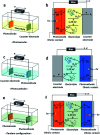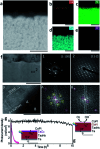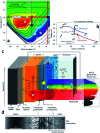A methodological review on material growth and synthesis of solar-driven water splitting photoelectrochemical cells
- PMID: 35530222
- PMCID: PMC9072205
- DOI: 10.1039/c9ra05341g
A methodological review on material growth and synthesis of solar-driven water splitting photoelectrochemical cells
Abstract
As a renewable and sustainable energy source and an alternative to fossil fuels, solar-driven water splitting with photoelectrochemical (PEC) cell is a promising approach to obtain hydrogen fuel with its near-zero carbon emission pathway by transforming incident sunlight, the most abundant energy source. Because of its importance and future prospects, a number of architectures with their own features have been formed by various synthesis and growth methods. Because the materials themselves are one of the most dominant components, they determine the solar-to-hydrogen efficiency of the PEC cells. Thus, several representative PEC cells were reviewed by categorizing them as per synthesis and/or growth methods such as physical vapor deposition, chemical vapor deposition, electrochemical deposition, etc. This review provides researchers with an overview and acts as a guide for research on solar-driven water splitting PEC cells.
This journal is © The Royal Society of Chemistry.
Conflict of interest statement
There are no conflicts to declare.
Figures












References
-
- Miller E. L. Energy Environ. Sci. 2015;8:2809. doi: 10.1039/C5EE90047F. - DOI
-
- Thomas H., Armstrong F., Brandon N., David B., Barron A., Durrant J., Guwy A., Kucernak A., Lewis M., Maddy J., Metcalfe I., Porch A., Abbott J., Adderly B., Banares R., Beckmann M., Bowen P., Cowan A., Anadon L. D., Dickens N., Dinsdale R., Dodds P., Hawksworth S., Heckenast Z., Holmes N., Howes J., Hutchings G., Irvine J., Loughhead J., Madden B., Newborough M., Oxburgh R., Philibert C., Salisbury A., Saltmarsh J., Selby M., Taylor C., Trezona R., Wilkinson I., Williams C., Surkovic E., Davies P., Clarke A. and Koppelman B., Options for producing low-carbon hydrogen at scale, Royal Society, 2018
-
- Milne T. A., Elam C. C. and Evans R. J., Hydrogen from Biomass State of the Art and Research Challenges, National Renewable Energy Laboratory, 2002, IEA/H2/TR-02/001
-
- Pagliaro M. Konstandopoulos A. G. Ciriminna R. Palmisano G. Energy Environ. Sci. 2010;3:279. doi: 10.1039/B923793N. - DOI
Publication types
LinkOut - more resources
Full Text Sources
Research Materials

